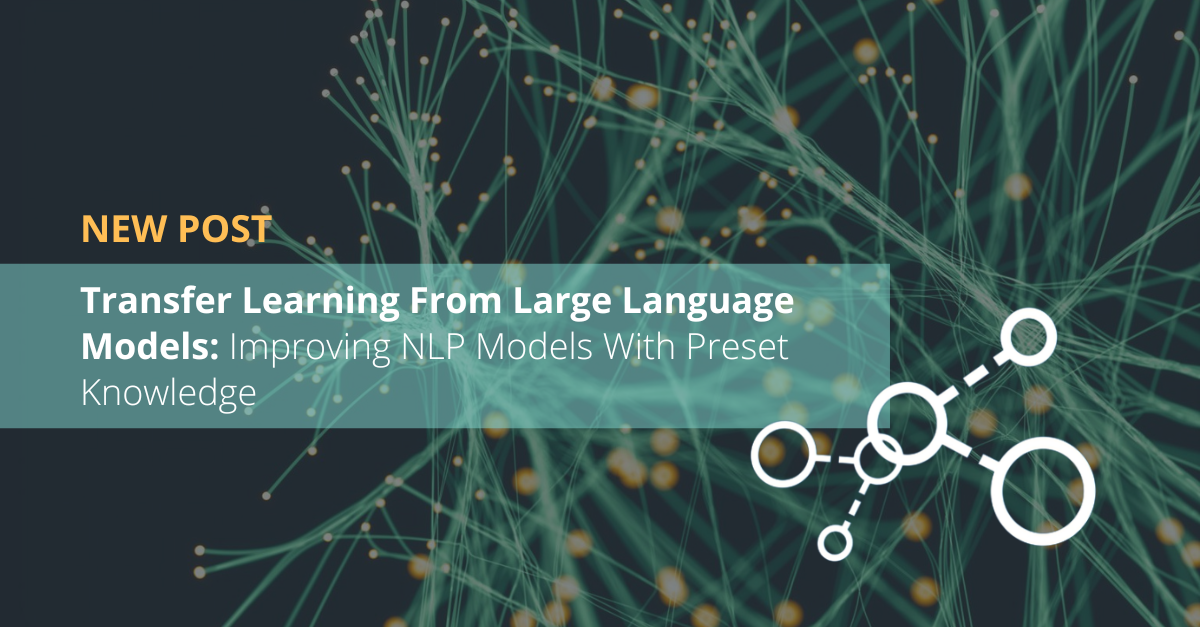
3 min read
17/07/2023
Transfer Learning From Large Language Models: Improving NLP Models With Preset Knowledge
Transfer learning from large language models is behind a multitude of successful launches and applications in recent times. While transfer learning as a concept is not new, its application to natural language processing is now opening particularly interesting doors: from chatbots to text generation and summarization.
Based on employing the knowledge of large language models to solve problems more efficiently, the advent of GPT or BERT has multiplied its popularity and applications. The result is more efficient and cost-effective text generation without compromising final quality. Let’s analyze it.
What is a large language model (LLM)?
Large language models (LLMs) are based on neural networks and machine learning from large volumes of text. This allows them to understand statistical patterns and language structure.
There are many LLMs in the market, some are closed like the GPT (Generative Pre-trained Transformer) series from OpenAI or Claude from Anthropic and others are open-source and can be customized like Meta’s Llama2, Alpaca, Vicuña or BERT (Bidirectional Encoder Representations from Transformers) from Google.
They are characterized by having been pre-trained using unsupervised learning methods and large amounts of data for LLMs. From that prior training, large language models can be employed for a multitude of text-related actions, including text classification, text generation, summarization, and machine translation.
Related content:
What is transfer learning?
Transfer learning is a technique based on the ability to use the training and knowledge acquired by a model to learn how to perform other tasks more efficiently.
In the context of LLMs, transfer learning from large language models to refers to the ability to employ knowledge from large language models to solve new tasks.
If traditional language models were trained from scratch, transferring the NLP learning entails a number of advantages. For example, this is a useful strategy when large amounts of data or resources are not available, or if you want to reduce the time required for training. In addition, transfer learning from large linguistic models allows for rapid and iterative research and testing.
You might be interested in:
How to boost your business with natural language processing (NLP)
How can large language models be used for transfer learning?
The basic notion for carrying out transfer learning in the context of LLMs is as follows: pre-train the language model and then add new layers on top of those that have already been trained. The model works because it has already learned about the nuances of language and is able to make generalizations and apply them to the new tasks proposed.
The process could be divided into the following phases:
-
Pre-training: large amounts of text data are used so that the model can learn about patterns and relationships in the language. This knowledge is oriented towards a multitude of tasks related to natural language processing.
-
Transfer learning: various techniques appear here, including feature-based transfer learning, or multitask learning. Others opt for fine-tuning models, which we describe below but which cannot be considered transfer learning as such.
-
Application: the model can later be used to make predictions based on new data.
Advantages and disadvantages of transferring NLP learning from large language models
Among the advantages of transfer learning from large language models are:
-
Reducing training times, taking advantage of the knowledge and resources of LLMs.
-
Improving performance in the new models, as LLMs are used as a foundation.
However, it is important to note that the transfer learning model also has some limitations:
-
Little flexibility in adapting to new domains.
-
If the data with which they were trained had biases, these will be transferred to the new model.
-
Regulations concerning data privacy must be taken into account, in particular when dealing with personal or sensitive data.
-
The operation may not be successful if the pre-training data are not useful for the rest of the operations.
Applications of transfer learning from large language models
Transfer learning from large language models is revolutionizing the areas of natural language processing that require deep knowledge of language. This includes applications in the following areas:
-
Interactions based on answers to questions
-
Text summarization
-
Creation of chatbots and virtual assistants
Read more:
What Is Deep Learning and How Does It Improve Machine Translation?
The role of fine-tuning in transfer learning for large linguistic models
The technique known as fine-tuning refers to continuing the training of an already pre-trained language model using smaller and more precise volumes of text. The aim is to make the language model learn more about a new task or domain and adapt to it.
Again, fine-tuning allows for time and resources to be saved, since it can be carried out with volumes of text that include hundreds or thousands of examples.
However, it differs from transfer learning in that fine-tuning trains already existing parameters to perform a second task; whereas transfer learning in NLP "freezes" the existing parameters, adding layers on top of them.
How Pangeanic can help you in transfer learning from large linguistic models
At Pangeanic, we are at the forefront of language technology and therefore we also apply transfer learning from large language models.
In particular, and in the context of our machine translation engine, this technique serves to improve the translation quality of low-resource language pairs.
As part of our work to increase the capabilities of Artificial Intelligence algorithms, we are often tasked with providing large amounts of high-quality data. However, another of our areas of expertise involves using transfer learning from large linguistic models to achieve the same goal: high-quality texts, translations and text analysis without wasting resources.
Contact our team and find out how we can help you.




